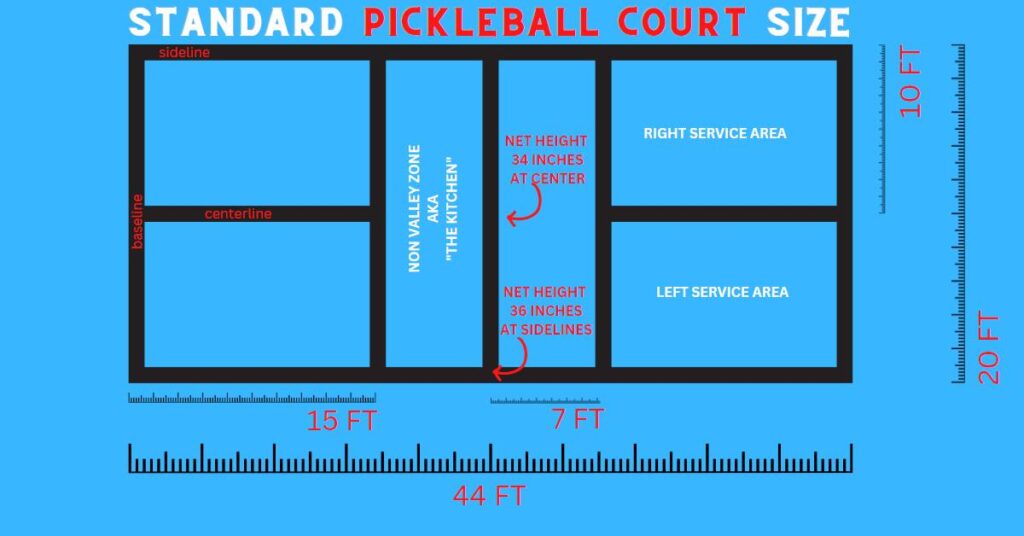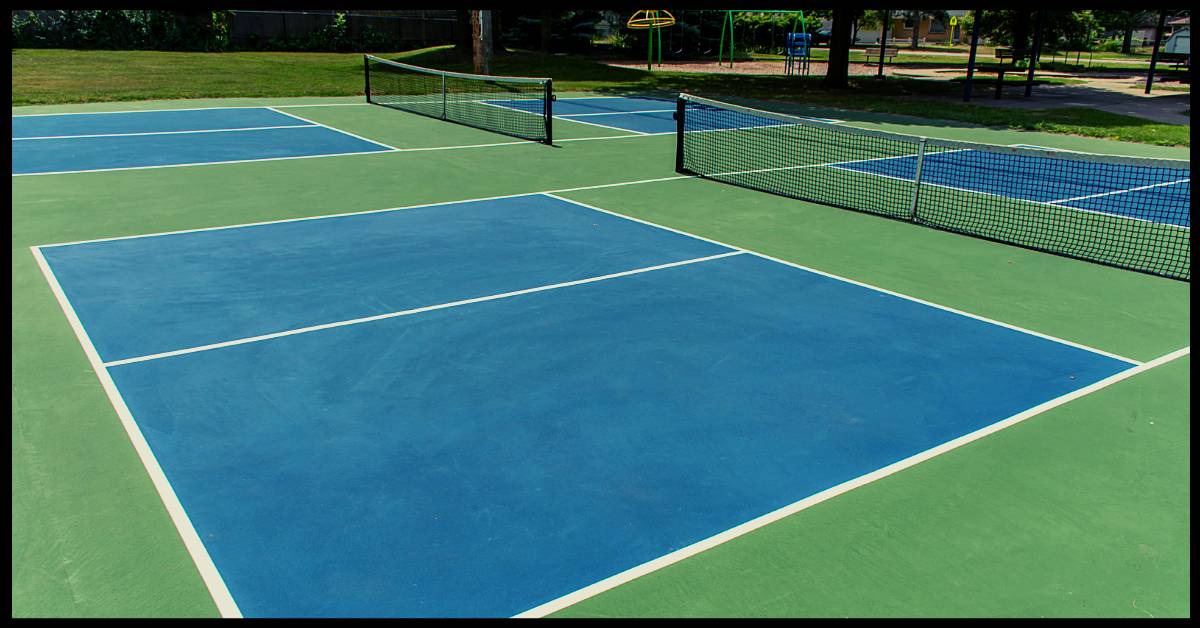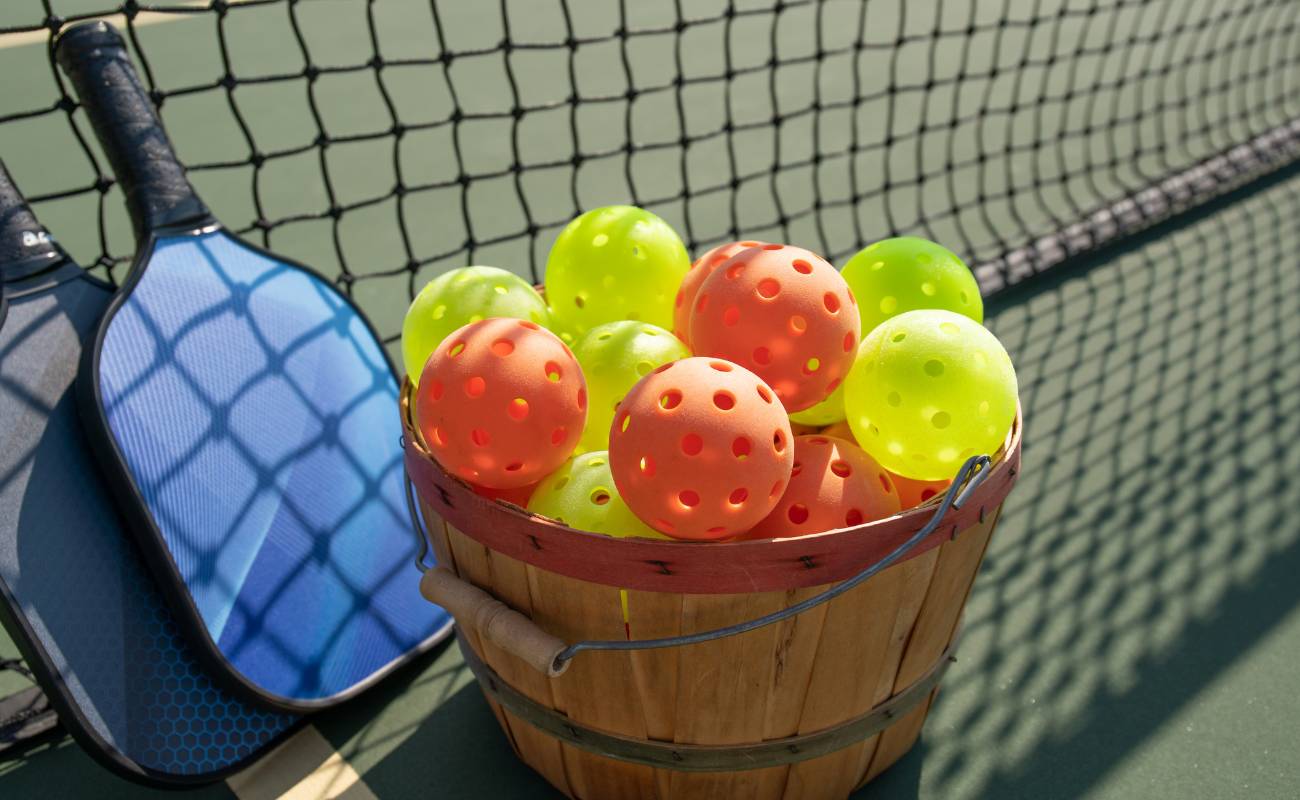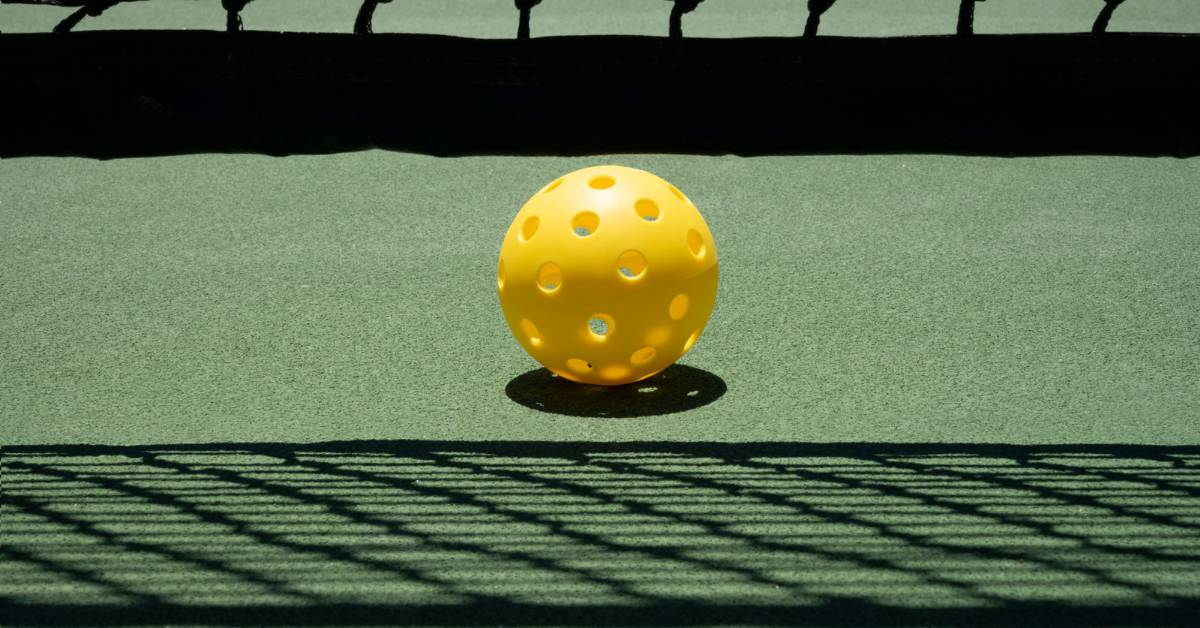If you’re new to the world of Pickleball, you may be curious about Pickleball court size. Don’t worry; we’re here to help! From beginner to expert level, this guide covers all the court dimensions and markings required for a standard pickleball court.
Standard Pickleball Cour Size

A regulation-sized pickleball court is 20 feet wide by 44 feet long. The overall court size is 44 feet long by 20 feet wide. The playing surface is made up of two separate courts that are each 20 feet wide by 22 feet long. Each side of the net has a 7-foot non-volley zone (also known as the kitchen) with an additional 1/2 foot behind it. The non-volley zone lines should be marked in a different color than the sideline and baseline to differentiate them from other lines on the court.
The centerline should be marked with a continuous line across the full width of the court and should be two inches wide. This area is used for serving, so it’s important that players know where it is located at all times. The centerline divides each side into two halves, which are 10 feet long by 20 feet wide each. The net height should be 36 inches tall at its center and 34 inches tall at its sides.
Markings and Equipment
Markings on a pickleball court include four baselines, four sidelines, one centerline, and two non-volley zones (also known as kitchens). All lines must be drawn in white or yellow paint on an outdoor surface or blue tape on an indoor surface; they should all measure two inches in width unless otherwise specified.

The minimum space required for a pickleball court is 26 x 42 feet; however, if possible, it’s recommended to have extra room around all sides of the court for safety purposes. In addition to the markings listed above, players will also need pickleball, paddles, nets, and hoops or posts for setting up a regulation-size pickleball court.
What is the regular height for a pickleball net?
The standard net height for pickleball is 36 inches at the center and 34 inches on the sides. This regulation of net height is necessary to ensure that all players have an equal chance of success in the game, regardless of their size or skill level. The lower side heights also help to keep balls from going over the top of the net while still providing enough room for volleys and returns. With a consistent net height, players can focus on honing their skills rather than worrying about whether they are playing under different rules than other courts. Additionally, having a standardized regulation makes it easier for tournaments to be held across multiple locations without any discrepancies between court sizes or heights.
A permanent post is usually installed in the ground at each end of a tennis court, with the net extending at least 1 foot past the edge of the sideline. The posts should be set 22 feet, 4 inches apart, and are typically constructed from steel pole material with an external diameter ranging from 2-3/8 to 3 inches. As these posts are exposed constantly to the elements, it is important to select rust-resistant materials whenever possible. Installers generally suggest setting the posts into a block of concrete with a protective ground collar for additional stability. A standard length for these posts is approximately 50 inches, and commonly, they are painted black or dark green.
DIY Guide To Create Your Own Outdoor Pickleball Court in No Time!

Building an outdoor court is an exciting DIY project that will be sure to provide hours of entertainment and exercise. In this blog post, we’ll provide a comprehensive guide on how to build your own outdoor pickleball court from start to finish.
1. Choose the Right Location
The first step for building an outdoor pickleball court is to choose the right location. You’ll want to look for a flat area with plenty of direct sunlight so the playing surface will stay dry and comfortable during play. If there are any trees nearby, make sure they aren’t close enough to create any unnecessary shade or wind interference. You’ll also want to check with local laws to make sure you can build the court without violating any zoning regulations.
2. Measure & Mark Out Your Boundaries
Once you’ve chosen a suitable spot for your court, it’s time to start measuring and marking out its boundaries.
Download the full layout of the Pickleball court with the dimensions in feet.
Start by stretching some string between two stakes at either end of where you’d like the court to be located—this will help you define your playing area’s width (20 feet). Then measure out 44 feet from one side of the court and mark this as the outermost boundary line using chalk or spray paint (the innermost boundary should be 34 feet from each side). Once all four lines have been marked off, use stakes and string to outline them more thoroughly if needed.
Popular surface materials:
No matter your needs or goals, there are a number of different court surface materials to choose from for your pickleball court. Concrete is the most popular and durable choice and is also good for value. Alternatively, asphalt can be a more affordable option but requires additional maintenance over time. For those unwilling to make permanent changes to an existing multi-use court, snap-together plastic surfaces are available and easy to install on top of either concrete or asphalt. The best choice ultimately depends on personal preference and budget, as well as the demands of the court and its players.
Lighting for your court:
Lighting plays an important role in ensuring that pickleball games can be enjoyed even at night. The optimal setup for Pickleball court lighting includes two 1,500-watt light poles mounted centrally and positioned 24″ away from the court. These light poles should be 18 to 20 feet high and installed in a way that the illumination is uniform. Pickleball enthusiasts need not worry anymore about the sun setting on their games as proper lighting will let them enjoy this fantastic sport late into the night.
3. Prepare The Base & Install The Net
Now it’s time to prepare the base of your outdoor pickleball court. Start by removing any obstructions in your playing areas, such as rocks, roots, or other debris that could interfere with gameplay. Then lay down 6-8 inches of compacted gravel so that it covers the entire surface evenly (this will help keep moisture away from your playing surface). After that’s done, install your portable pickleball net according to its instructions—make sure it’s securely anchored at both sides so it won’t move while in use!
That’s it! You now have everything you need for an awesome outdoor pickleball court! To wrap up this DIY guide, here are a few tips for maintaining your new space:
- Make sure you clean up after every game
- keep weeds away by using weed killer around the perimeter
- check periodically for any tears in nets/lines/stakes; replace worn nets as necessary
- and lastly — have fun!
Enjoy this great sport with friends and family for years to come! Now go grab some paddles and balls — let’s get started!
How does a pickleball court compare to other racquet courts
Pickleball courts are much smaller than many other standard sporting courts, making them the perfect fit for any situation.
Vs. Badminton court:
A Doubles Badminton court is the same size as a pickleball court – it’s just the net height that differs.
Vs. Tennis Court:
As for other popular sports, you can fit four pickleball courts within a Tennis court, while only one can be contained inside a Volleyball court.
Vs. Squash Court:
A Pickleball court takes up around a quarter of the size of the standard Squash court.
Vs. Other sports:
Moreover, you can squeeze in 4 pickleball courts crosswise onto a Basketball court (92 ft x 50 ft), and Futsal pitches can accommodate up to 4 of these mini-courts simultaneously. With all the varying possibilities, there’s sure to be a place for you to get out and enjoy the game of pickleball!
Besides their smaller size, Pickleball courts also differ in that they are generally made from non-slip surfaces such as concrete or asphalt. This ensures players have a good grip on the court surface and helps reduce any potential injuries. Additionally, many pickleball courts feature outdoor lighting for evening games, which can give them an advantage over other sporting facilities.
Overall, pickleball courts are a great option if you’re looking to save space and money while still having access to all the necessary features required for an enjoyable game of pickleball.
What are the dimensions of a standard pickleball court in meters?
The length of a standard pickleball court is 6.10 meters, and its width is 13.41 meters. These dimensions are perfect for up to four players and ensure an enjoyable game for all involved. Additionally, it allows players to experience the full range of motion movements as they engage in friendly competitions or high-level tournaments. The dimensions of the court also create an ideal setting for teams to display their skills and strategy knowledge, so if you’re looking for an exciting and competitive match of pickleball, then make sure your court follows these specifications!
What is the official height of the pickleball net in cm?
As the game has evolved, so has the official height of the pickleball net. According to governing bodies, the official height of a pickleball net is 76 cm (or 30 inches) when measured at its center point. It is also important to note that the regulation states that each side of any given pickleball court must be in line with one another at this height. The only exception is when playing outdoors, as the wind can cause nets to move up or down slightly, and this difference in heights must be taken into account by referees overseeing such games.
Conclusion
Whether you’re just starting out or looking to sharpen your competitive skills as a more experienced player – understanding Pickleball Court size in Feet can help make sure your game goes off without a hitch! Now that you know what makes up an officially sized Pickleball Court, get out there and enjoy some friendly competition!

![Pickleball Certification [Cost, Benefits & Test Advice]](https://texasopenpickleball.com/wp-content/uploads/2023/01/Pickleball-Certification-150x150.jpg)



